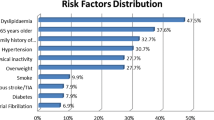Abstract
Objectives
The public health programme “Healthy Lower Rhine…against Stroke” is aimed at improving the population’s knowledge about stroke and thus at reducing the prehospital phase in patients with suspected stroke. First evaluation results indicate that apart from providing information through the mass media, there is an urgent need to further develop the face-to-face communication approach. This has to be achieved by efficient but also effective means, given that financial and personnel resources are scarce.
Study design
In cooperation with lögd Bielefeld, the Lower Health Authority of the Wesel District (health department) developed a postcard-sized quiz card containing exclusively correct answers on the issue of stroke, risk factors as well as symptom and action knowledge. For face-to-face communication, the hairdressers could be convinced to be included in the project. The hairdressers posed the corresponding questions and marked those answers of the clients that were identical with the quiz card answers with a cross. Answers not given by the clients were read out loud to them by the hairdressers, who were thus “styling up” the knowledge of their clients. To increase participation in the project, prizes were offered for the hairdressers with the most filled-in quiz cards as well as for three of the participating clients (drawing of prizes 1–3). More than 380 hairdressers in the Wesel district were sent a letter inviting them to participate as facilitators in this project, which is probably the first of its kind worldwide.
Methods
The machine-readable quiz cards were collected and statistically evaluated including data regarding age and gender of the participants. Results were to be presented in the form of a descriptive statistic.
Results
Thirty-three hairdressers from 12 cities and municipalities of the Wesel district participated in this joint action of the Wesel district Department of Health and the Wesel hairdressers’ guild, dealing with the monitoring and imparting of basic knowledge on the issue of stroke. Almost 2,000 clients were interviewed by the participating hairdressers, and knowledge gaps were closed by information read out to them.
Discussion
This innovative approach of imparting knowledge can be regarded as the model of an effective and economical way of communicating health information to the broader public.

Similar content being viewed by others
References
Brand H, Schmacke N, Brand A (2003) Der öffentliche Gesundheitsdienst–Zukünftige Aufgabenbereiche des öffentlichen Gesundheitsdienstes. In: Schwartz FW, Badura B, Busse R et al (eds) Public health – Gesundheit und Gesundheitswesen. Urban & Fischer, Munich-Jena, pp 367–375
Hess PL, Reingold JS, Jones J et al (2007) Barbershops as hypertension detection, referral, and follow-up centers for black men. Hypertension 49(5):1040–1046
Kotler P, Roberto E (1989) Social marketing. Strategies for changing public behavior. The Free Press, New York, pp 20–23
Linnan LA, Kim AE, Wasilewski Y, Lee AM, Yang J, Solomon F (2001) Working with licensed cosmetologists to promote health: results from the North Carolina BEAUTY and Health Pilot Study. Prev Med 33(6):606–612
Murza G, Werse W, Brand H (2005) Ortsnahe Koordinierung der gesundheitlichen Versorgung in Nordrhein-Westfalen. Bundesgesundheitsbl-Gesundheitsforsch-Gesundheitsschutz 48:1162–1169
Naidoo J, Wills J (2003) Der Einsatz der Massenmedien in der Gesundheitsförderung. In: Bundeszentrale für gesundheitliche Aufklärung (ed) Lehrbuch der Gesundheitsförderung. Cologne pp 239-256
Pfeiffer H, Rau R, Mensing M, Schneitler H, Brand H (2006) Schlaganfall-Prävention: Identifizierung von Präventionspotenzialen durch Bevölkerungssurveys. Präv Gesundheitsf 1:99–107
Pott E: Strategien des sozialen Marketing. In: Schwartz FW, Badura B, Busse R et al (eds) Public Health–Gesundheit und Gesundheitswesen. Urban und Fischer, Munich–Jena pp 215-229
Rau R, Rumpeltin C (2003) Netzwerk Gesunder Niederrhein: Überregionale Schlaganfall-kampagne ab Mai 2003. Blickpunkt öffentliche Gesundheit 2:4–5
Rau R, Mensing M, Brand H (2006) Schlaganfall-Wissen der Bevölkerung: Survey im Kreis Wesel (2002). Bundesgesundheitsbl–Gesundheitsforsch–Gesundheitsschutz 49:450–458
Rau R, Otten K, Genz J, Geraedts M (2008) Evaluation des Public Health-Programms “Gesunder Niederrhein...gegen den Schlaganfall” durch Primärdaten aus Kliniken im Kreis Wesel-Vergleichende Studie von Stichprobendaten aus den Jahren 2003 und 2005. Med Klin 103:20–28
Solomon FM, Linnan LA, Wasilewski Y, Lee AM, Katz ML, Yang J (2004) Observational study in ten beauty salons: results informing development of the North Carolina BEAUTY and Health Project. Health Educ Behav 31(6):790–807
Acknowledgements
The authors would like to thank Klaus-Peter Neske, Senior Master Craftsman of the Hairdressers’ Guild of the Wesel District in Xanten, for his cooperation and support of the project. Special thanks go to Mrs. Barbara Leifeld from Krefeld for drafting the quiz card and to Mrs. Rehkämper (LIGA NRW, Bielefeld) for translating the text into English.
Conflict of interest
The authors disclose any relevant associations that might pose a conflict of interest.
Author information
Authors and Affiliations
Corresponding author
Additional information
This paper describes a new approach to cost-effective health information and communication in public health practice.
Rights and permissions
About this article
Cite this article
Leifeld, T., Rau, R. & Mensing, M. Community stroke knowledge: a new information strategy using a joint project of the public health service and the hairdressers’ guild of the Wesel district. J Public Health 17, 371–376 (2009). https://doi.org/10.1007/s10389-009-0253-x
Received:
Accepted:
Published:
Issue Date:
DOI: https://doi.org/10.1007/s10389-009-0253-x




